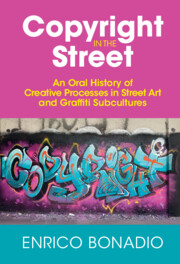59 results
5 - The Subcultures between an Anti-Establishment Ethos and the Mainstream
-
- Book:
- Copyright in the Street
- Published online:
- 20 April 2023
- Print publication:
- 27 April 2023, pp 104-135
-
- Chapter
- Export citation
Contents
-
- Book:
- Copyright in the Street
- Published online:
- 20 April 2023
- Print publication:
- 27 April 2023, pp vii-viii
-
- Chapter
- Export citation
Foreword
-
- Book:
- Copyright in the Street
- Published online:
- 20 April 2023
- Print publication:
- 27 April 2023, pp vii-xii
-
- Chapter
- Export citation
Copyright page
-
- Book:
- Copyright in the Street
- Published online:
- 20 April 2023
- Print publication:
- 27 April 2023, pp iv-iv
-
- Chapter
- Export citation
Dedication
-
- Book:
- Copyright in the Street
- Published online:
- 20 April 2023
- Print publication:
- 27 April 2023, pp v-vi
-
- Chapter
- Export citation
2 - Creativity and Originality of Graffiti Lettering
-
- Book:
- Copyright in the Street
- Published online:
- 20 April 2023
- Print publication:
- 27 April 2023, pp 15-34
-
- Chapter
- Export citation
6 - Sharing, Biting, and Social Norms
-
- Book:
- Copyright in the Street
- Published online:
- 20 April 2023
- Print publication:
- 27 April 2023, pp 136-158
-
- Chapter
- Export citation
Epilogue
-
- Book:
- Copyright in the Street
- Published online:
- 20 April 2023
- Print publication:
- 27 April 2023, pp 160-162
-
- Chapter
- Export citation
Epilogue
-
- Book:
- Copyright in the Street
- Published online:
- 20 April 2023
- Print publication:
- 27 April 2023, pp 159-161
-
- Chapter
- Export citation
Foreword
-
- Book:
- Copyright in the Street
- Published online:
- 20 April 2023
- Print publication:
- 27 April 2023, pp ix-xiv
-
- Chapter
- Export citation
1 - Introduction
-
- Book:
- Copyright in the Street
- Published online:
- 20 April 2023
- Print publication:
- 27 April 2023, pp 1-14
-
- Chapter
- Export citation
4 - Feelings about Attribution and Preservation
-
- Book:
- Copyright in the Street
- Published online:
- 20 April 2023
- Print publication:
- 27 April 2023, pp 61-103
-
- Chapter
- Export citation
3 - Copyright within Street Art and Graffiti Circles
-
- Book:
- Copyright in the Street
- Published online:
- 20 April 2023
- Print publication:
- 27 April 2023, pp 35-60
-
- Chapter
- Export citation

Copyright in the Street
- An Oral History of Creative Processes in Street Art and Graffiti Subcultures
-
- Published online:
- 20 April 2023
- Print publication:
- 27 April 2023
Figures and Tables
-
- Book:
- The Cambridge Handbook of Investment-Driven Intellectual Property
- Published online:
- 16 March 2023
- Print publication:
- 23 March 2023, pp vii-viii
-
- Chapter
- Export citation
Part I - Science, Technology and Industry
-
- Book:
- The Cambridge Handbook of Investment-Driven Intellectual Property
- Published online:
- 16 March 2023
- Print publication:
- 23 March 2023, pp 25-152
-
- Chapter
- Export citation
Part III - Signs, Images and Designs
-
- Book:
- The Cambridge Handbook of Investment-Driven Intellectual Property
- Published online:
- 16 March 2023
- Print publication:
- 23 March 2023, pp 259-260
-
- Chapter
- Export citation
Contents
-
- Book:
- The Cambridge Handbook of Investment-Driven Intellectual Property
- Published online:
- 16 March 2023
- Print publication:
- 23 March 2023, pp v-vi
-
- Chapter
- Export citation
XI - Protecting Sound Recordings
- from Part II - Culture and Entertainment
-
-
- Book:
- The Cambridge Handbook of Investment-Driven Intellectual Property
- Published online:
- 16 March 2023
- Print publication:
- 23 March 2023, pp 182-202
-
- Chapter
- Export citation
Part II - Culture and Entertainment
-
- Book:
- The Cambridge Handbook of Investment-Driven Intellectual Property
- Published online:
- 16 March 2023
- Print publication:
- 23 March 2023, pp 153-258
-
- Chapter
- Export citation



